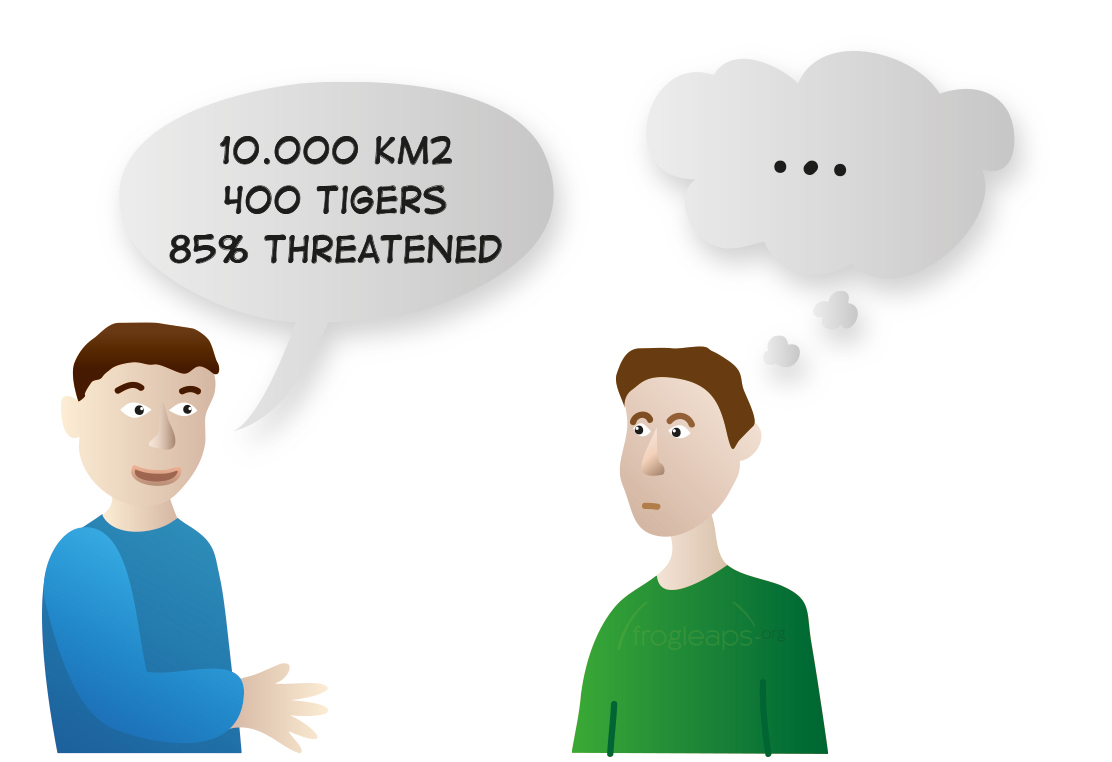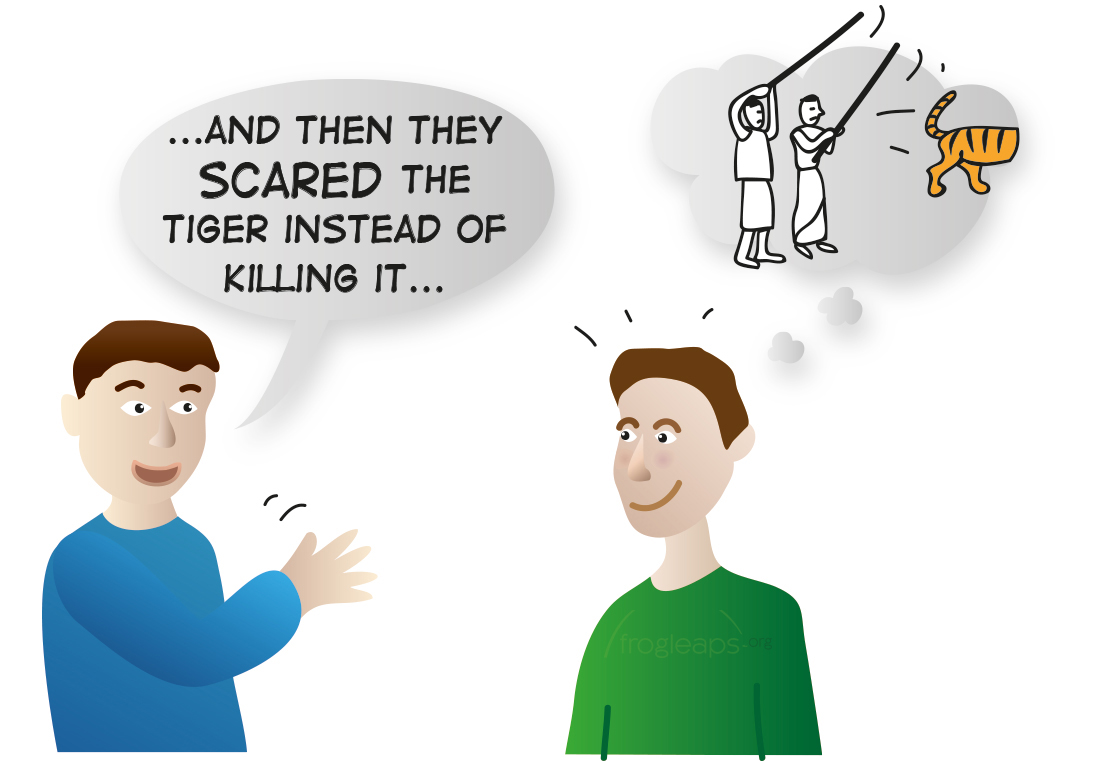What is the power of storytelling?
Storytelling can do more for your strategic change than you would expect at first sight. Why is storytelling a powerful means to inform and persuade your target audiences?
- Our brains are built to learn from stories
- Stories grab and maintain attention; stories help to us to understand and remember messages
- Stories touch our emotions and create empathy, empathy is needed to engage target audiences for your conservation action
Our brains are built to learn from stories
Our brains are hardwired for stories as a way to organize information and help us to orient ourselves. They help make sense of the complex world. Humans are focused on understanding and recognizing patterns and to understand new concepts and ideas. Stories offer such patterns. Stories are built on causes and effects. One event leads to another. We think in narratives all day long. ‘If I take this action, I hope to get this result.’ This is an unconscious, uncontrollable process.
Since the beginning of time, humans educated younger generations using stories. Most part of our existence, all knowledge and values were transferred from generation to generation just by using oral stories.
Stories grab and maintain attention; they help us understand and remember
We live in a sea of information. How can you attract your target audience to listen when they are bombarded with messages every day?
Good stories help people remember messages, not only for five minutes but –if the story is strong enough- for a lifetime. How many stories do you remember from your childhood?
Stories bring facts to life and infuse them with passion. You hear a good story with your head and your heart. You become an active participant instead of a passive listener.
If a story is well told, you’re experiencing it as if you were there. You feel what the storyteller feels. You see and hear what the storyteller sees and hears. You memorize the messages of the story because you see the images, hear the sounds, and feel the emotions. The story engages your attention on different levels, so when the storyteller reveals the central message, it sticks.
Have you ever listened to long presentations and had a hard time remembering most of the info, but when you got back home you re-told the good story of one of the speakers? This is because stories stick! Storytelling provides a stronger and deeper experience then a rational and factual presentation.
When you only tell your audience a lot of facts, there is high chance they won’t remember. A power point presentation summing up facts with bullet points activates only our language processing part in the brain, where we decode words into meaning. Nothing else happens.
If a storyteller tells about a delicious meal, describing vividly the taste and smells, the listener will taste and smell it as well. The sensory cortex, the part of the brain used for these senses, is activated.
If a storyteller tells vividly about being attacked by a pack of angry howling wolves, having to run for his life, the listener will run with him. The motor cortex, the part of the brain involved in all our motions, is activated when listening or reading the story.
The following sketches illustrate the power of storytelling versus the limited effect of factual information.

Factual info: not effective in most cases

Storytelling engages the listener on many levels
So stories help us to remember by activating many parts of the brain instead of only activating the parts used to process factual information. In the words of Annette Simons in her book “The Story Factor”: “We neglect the most important criteria most people use to decide whether to listen to us or not. We spend too much time talking to a person’s rational brain and we neglect their emotional brain.”
Example of an experiment proving that stories are much better remembered
The book ‘Stories that Move Mountains’ describes a fascinating showcase of the power of storytelling:‘Chip and Dan Heath run an annual class at Stanford University in California. The students are asked to deliver a one-minute persuasive speech to their peers. All the students are provided the same data. Half of the students must argue for one point of view, the other half for the opposite point of view.
As you might imagine with Stanford students, these are typically good quality presentations that clearly impart data and arguments. After the presentations, the audience is distracted for a few minutes with a comedy video and then asked to write the key points from each speech they heared, working from memory because they have no notes to refer to.
The students are surprised at how little they can remember. It’s not although they had a lot to remember, just eight one-minute speeches. These are well-educated people, being presented to by some of the brightest students on the planet. Although only one in ten students will use the presentation to tell a story, leverage emotion, or really focus on a key message, the evidence shows that sixty-three percent of the audience can remember facts from the story-telling presentations, compared with only five percent from the rest. This was one of the tipping points for me. It proves clearly that the use of stories can make your ideas stick in the minds of your audience.’
Source: Martin Sykes. A. Nicklas Malik and Mark D. West, Stories that Move Mountains, Storytelling and Visual Design for Persuasive Presentations, 2013
Stories touch our emotions and engage us
Why do we need to touch the emotions of our target audiences to get them on board for conservation action? If they already know and understand the facts, isn’t that enough? No, it’s not! Read the text below and you will find out.
Factual information versus a story that touches us
To understand why we respond to compelling stories about individuals instead of factual information about a big problem, we will tell you about a scientific experiment explained by Dan Ariely in his book ‘The upside of irrationality’.
Experiment: Factual info versus emotional info
Participants in the experiment were given information about hunger in Africa and were asked for a donation.
One group received factual and statistical information about the cause of the problem and the number of hungry people: ‘Food shortages in Malawi are affecting more than 3 million children. In Zambia, severe rainfall deficits have resulted in a 42% drop in the maize production from 2000. As a result, an estimated 3 million Zambians face hunger. 4 million Angolans –one third of the population- have been forced to flee their homes. More than 11 million people in Ethiopia need immediate food assistance.’
A second group received information about Rokia, a desperately poor seven-year-old girl from Mali who faced starvation. The participants looked at her picture and read the following statement: ‘Her life would be changed for the better as a result of your financial gift. With your support, and the support of other caring sponsors, Save the Children will work with Rokia’s family and other members of the community to help feed her, provide her an education, as well as basic medical care and hygiene education.’
Guess which group donated more?
The group presented with the identifiable victim Rokia donated twice as much as the group who received the statistical information! These results are already depressing but there is more. There was also a group of participants who read both the factual information as the info about Rokia.
What do you think was the result? Did the willingness to support increase by adding emotional information?
Unfortunately it hardly did. Apparently, it is difficult for humans to think rationally and feel emotion at the same time.
Conclusion
Taken together, the results of this experiment tell a sad story. When we care about an individual victim or animal, we take action but when an entire group or species is at danger, we don’t. We don’t step into help when we should, other times we help when it’s irrational as the true story of penguin Happy Feet illustrates. And cold calculation does not increase our concern for large problems. Instead, it suppresses our compassion. It blocks action and hinders behaviour change.
Source: Dan Ariely, On Empathy and Emotion: Why We Respond to One Person who Needs Help but Not to Many, The Upside of Irrationality, 2010

